From Decision Theory to Informed Decision-Making in the Design of Sustainable High-Performance Buildings
Abstract
:1. Introduction
“…., the supremacy of consumerism and industrialization during the 1950s resulted in perceiving design knowledge as essential for improving production, developing processes to suit intended qualities in the end product, and implementing designs to accommodate users’ needs. Architecture and allied design and built environment disciplines considered performance as a goal, leading to a sustained quest by design researchers to make the design process more efficient and effective. Consequently, during the following decades and up to the late 1980s, a rational approach to knowledge acquisition, assimilation and accommodation in a systematic design process has dominated design discourse”.
What happens to the quality of decisions when moving from sole-form design decisions to more collaborative, integrated, and participatory multi- or interdisciplinary design decisions in the (early) design stages?
- -
- the first issue involves determining what solution or decision should be adopted, and
- -
- the second issue revolves around not what should be decided but how and with whom it should be decided.
RQ: To what extent and with whom should one participate in decision-making when (early stage) decisions are made relating to the design criteria in the design of sustainable high-performance buildings?
2. Decision-Making Theory
2.1. Normative Model of Decision-Making
- -
- The technical quality or rationality of the decision.
- -
- The acceptability of the decision or the commitment of those responsible for its execution.
- -
- The time required to make the decision.
3. Design of Sustainable High-Performance Buildings
3.1. Design Process
- Pre-design: the principal consultant (lead architect/project manager) consults with the client to establish project goals and requirements.
- Concept design: the initial architectural design is developed, e.g., through an architectural competition for general contract projects or through requests for proposals for design-build projects.
- Schematic design: architectural proposal and possibly other requirements, depending on the RFP.
- Outlined proposal: the design is a substantiated proposal for the completion of the project, including a description and sketches of the design principles and major systems for technical facilities.
- Project proposal: a revision of the approved outline proposal to the extent that all key decisions for the project have been made and are included in the proposal.
3.2. Design Stakeholders
3.3. Sustainable Design Objectives and Criteria
4. Methodology
- (a)
- when and with whom a decision is made in the design of sustainable high-performance buildings (refer to the round one assessment survey), and
- (b)
- to what extent a decision can be made autocratically or participatorily in the design of sustainable high-performance buildings (refer to the round two assessment survey).
4.1. Study Design and Respondents
4.2. Analytical Strategy
5. Results
5.1. Round One Survey: Assessment of the Design Process, Stakeholders, and Sustainability Criteria
- Reading from part “a” in Table 4: The DGNB criteria with the highest weighting factor, including ENV1, ENV2, ECO1, SOC1, SOC2, SOC8, TEC1, TEC3, TEC6, PRO2, PRO3, SITE4 have, individually, the strongest relevancy degree to the pre-design stage, as well as the tendency toward knowledge sharing, which often requires more interaction with the listed stakeholders.
- Reading from part “b” in Table 4: Architects and architectural engineering teams have the greatest relevancy degree associated with the criteria in the ENV, SOC, and SITE qualities. Occupant relevancy is strongest concerning the criteria in SOC quality, whereas owners have a significant degree of decision-making relevancy with the criteria in the ECO, ENV, and SITE qualities.
- Reading from part “c” in Table 4: It is evident that almost all the decision stages and decision-makers are relatively relevant and must be involved when necessary. The rank order of the decision stages from highly relevant to less includes (1) pre-design, (2) concept design, (3) schematic design, (4) outlined proposal, and (5) project proposal stages, which is in every detail identical to that presented in Figure 3, i.e., the MacLeamy graph, reiterating the relevancy and importance of decision-making in the early design stages. In addition, architecture and architectural engineering teams, besides the owner (and client), have received the strongest relevancy degree. In contrast, engineering teams and contractors are in second place, and finally, occupants are at the end.
5.2. Round Two Survey: Empirical Application of the Normative Decision-Making Model in the (Early) Design Decision Process of Sustainable High-Performance Buildings
- -
- The decision-making features related to the criteria in SOC (with MPL = 7.3 and SD = 0.55) and PRO (with MPL = 3.52 and SD = 1.05) qualities have the strongest tendency toward participation and autocracy, respectively. That denotes the decision-making tendency associated with the SOC criteria (e.g., SOC6 criterion with the most significant trend toward participation) is more towards knowledge integration and knowledge sharing, which often requires more interaction and dialog and is more time consuming, while the tendency associated with the PRO criteria (e.g., PRO5 criterion with the most significant trend toward autocracy) is for design/team leaders to make the decisions. In the latter case, leaders often obtain the necessary information from their subordinates (or team/group members) and then decide how to proceed with the situation. Leaders may discuss with their subordinates the purpose of the questions or provide information about the decision situation they are dealing with. Thus, the subordinates’ contribution is a reaction to providing certain information. As a result, subordinates do not play a role in defining the situation or problem, nor in developing or considering alternative solutions.
- -
- The overall rankings of the five processes for all criteria from most to least frequently used are CI (with 122 votes, MPL = 3.21, SD = 0.93), CII (with 104 votes, MPL = 2.73, SD = 1.26), AII (with 91 votes, MPL = 2.39, SD = 1.58), GII (with 72 votes, MPL = 1.89, SD = 1.44), and AI (with 67 votes, MPL = 1.76, SD = 1.71). This indicates that the general decision-making style, with an overall MPL = 5.11 and SD = 1.78, tends toward CI, with team leaders discussing the problem with the affected subordinates individually, soliciting their responses and recommendations without bringing them together as a group, and then making the decision. Given this background, the decision may or may not reflect the influence of subordinates.
6. Discussion
- -
- Existing knowledge is too limited, and the problems are too complex to justify explicit normative models (such as Vroom’s decision-making styles in Figure 1) to solve decision-making issues in designing sustainable, high-performance buildings. Common questions may arise: Are the results in their current form an adequate guide to practice? Would those involved in planning make fewer mistakes in their decision-making choices if the results guided them? It would not be entirely honest to claim that such questions’ answers are known. But, as emphasized by Vroom and Yetton [38], the reader should be prepared that the issues surrounding the application and assessment of the normative or prescriptive model results are complex, and the methodology for answering questions of validity through empirical research has not yet been developed within the scope of this work.
- -
- As articulated in Section 1, current research aims to improve the early design decision stages, where decision-making is often more challenging. Therefore, the goal is to support the decision-making process, not to make the decision itself. In other words, the vision is not about perfection but an improvement in present practices. Any actions, even with minor impacts on the early stage of decision-making processes, might cause significant consequences later and thus be worth trying. On promoting and applying normative decision models, as was performed in this study, Vroom [27] argues that:
“…Moving from the autocratic to highly participative styles increases the potential value of the group or team to the organization in three ways: (1) It develops the knowledge and competence of individual members by providing them with opportunities to work through problems and decisions typically occurring at higher organizational levels. (2) It increases teamwork and collaboration by providing opportunities to solve problems as part of a team. (3) It increases identification with organizational goals by giving people “a voice” in making significant decisions in their organizations…”
7. Conclusions and Further Research Work
- -
- The surveys conducted were very challenging because of the need to consider all sustainability criteria at once and to find experts who are knowledgeable about all criteria and willing to invest time in the surveys. This is an obvious limitation of the current study, as only a limited number of interviews were conducted. Similar work can be completed with more participants focusing on specific sustainability qualities/criteria/indicators and associated decision stages. Similarly, further studies can be conducted with a more in-depth analysis of decision makers, e.g., focusing individually on multiple design professionals in architecture and civil engineering, owners and developers, contractors, subcontractors, and suppliers (which was not the case in the current study).
- -
- The present study avoids giving a specific decision-making situation or example of the participants and professionals interviewed in order to ensure the objectivity of the results. However, similar research can be conducted to analyze actual design decisions in actual design projects with actual project participants. This will require a great deal of passion, time, and resources, as it will be challenging to collect data from multiple stakeholders, with limited time and multiple levels of confidentiality in data collection.
- -
- This paper examined design stakeholders based on their role, expertise, and involvement in the design process; however, from the perspective of normative decision theory, similar research can be implemented with a focus on the descriptive types of decision-makers, such as being a brand-centric decision-maker, or multifocal decision-maker, aggregator, charismatic, skeptic, follower, etc., and how these features can influence design decisions towards improving the decision qualities and effectiveness. Likewise, further work can be completed related to behavioral decision-making [32,63] by studying the psychological underpinnings of human judgment, decision-making, and behavior, and how eventually people (in this case, design stakeholders) make decisions. That could also be extended towards further study of decision models from other views, such as rational, bounded rationality, intuitive, or creative decision-making.
- -
- What does informed decision-making mean?
- -
- Who is an appropriate decision maker?
- -
- How can a decision be made quickly and with greater accuracy?
- -
- Can decision-making be simplified?
- -
- Do stakeholders who have more information make better decisions?
- -
- Does the way the information is presented change the decision impact?
- -
- What is the best way to structure decision-making?
- -
- Does design context affect decision-making in terms of design and performance variables?
- -
- Does the effectiveness of information in decision-making differ by project context?
Funding
Institutional Review Board Statement
Informed Consent Statement
Data Availability Statement
Acknowledgments
Conflicts of Interest
Appendix A
| MS for the Decision-Stage Degree of Relevancy | Criteria (Weighting Factor–Share of Total Score Percentage)–(The Original Numbering Format from the Manual) | Mean Score (MS) for the Decision-Maker Degree of Relevancy | ||||||||||
| a * | b | c | d | e | a | b | c | d | e | f | g | |
| 5 ** | 4.5 | 4.5 | 2.5 | 2 | ENV1 *** (8–9.5%)–(ENV1.1) Building life cycle assessment | 4.5 | 5 | 4 | 4 | 1.5 | 2 | 1 |
| 4.5 | 2.5 | 5 | 4 | 3 | ENV2 (4–4.7%)–(ENV1.2) Local environmental impact | 5 | 5 | 3.5 | 4 | 2.5 | 3 | 1 |
| 5 | 2.5 | 3.5 | 4 | 2 | ENV3 (2–2.4%)–(ENV1.3) Sustainable resource extraction | 4 | 4.5 | 2 | 4 | 3.5 | 3.5 | 1.5 |
| 4 | 1 | 2 | 3.5 | 1 | ENV4 (2–2.4%)–(ENV2.2) Potable water demand and waste water volume | 2 | 3.5 | 1 | 4.5 | 1.5 | 2.5 | 1 |
| 5 | 2.5 | 1 | 1.5 | 2 | ENV5 (2–2.4%)–(ENV2.3) Land use | 3 | 1.5 | 2.5 | 2.5 | 4 | 4.5 | 1.5 |
| 5 | 4.5 | 3 | 3 | 3 | ENV6 (1–1.2%)–(ENV2.4) Biodiversity at the site | 5 | 4 | 2 | 2 | 2 | 2.5 | 3 |
| 4.5 | 2 | 2.5 | 3.5 | 3 | ECO1 (4–10.0%)–(ECO1.1) Life cycle cost | 4 | 3.5 | 1.5 | 3 | 3.5 | 4.5 | 2.5 |
| 5 | 4 | 2 | 2 | 3.5 | ECO2 (3–7.5%)–(ECO2.1) Flexibility and adaptability | 3 | 3.5 | 2.5 | 3 | 3 | 4 | 3 |
| 4.5 | 4.5 | 2.5 | 3 | 2 | ECO3 (2–5.0%)–(ECO2.2) Commercial viability | 4.5 | 4 | 3 | 2 | 2 | 5 | 2 |
| 2.5 | 4.5 | 5 | 3.5 | 1.5 | SOC1 (4–4.3%)–(SOC1.1) Thermal comfort | 4.5 | 4.5 | 1 | 4 | 1.5 | 1 | 3.5 |
| 2.5 | 4.5 | 4.5 | 3.5 | 1.5 | SOC2 (5–5.4%)–(SOC1.2) Indoor air quality | 4 | 4.5 | 1 | 4 | 1 | 2.5 | 3.5 |
| 2 | 3 | 4.5 | 4 | 3 | SOC3 (0–0%)–(SOC1.3) Acoustic comfort | 4 | 5 | 3.5 | 3 | 3 | 1.5 | 3 |
| 4 | 4.5 | 4.5 | 1.5 | 1.5 | SOC4 (3–3.2%)–(SOC1.4) Visual comfort | 5 | 5 | 2.5 | 1.5 | 1.5 | 3.5 | 4 |
| 3.5 | 3 | 3.5 | 4 | 3.5 | SOC5 (2–2.1%)–(SOC1.5) User control | 2 | 3.5 | 2 | 4.5 | 1.5 | 3.5 | 3.5 |
| 3 | 4.5 | 4.5 | 1.5 | 2 | SOC6 (2–2.1%)–(SOC1.6) Quality of indoor and outdoor spaces | 5 | 5 | 4 | 2 | 1 | 3 | 4 |
| 3 | 4.5 | 4 | 1.5 | 1.5 | SOC7 (1–1.1%)–(SOC1.7) Safety and security | 5 | 2.5 | 1.5 | 1.5 | 1 | 1.5 | 3.5 |
| 4.5 | 4 | 4.5 | 3 | 3 | SOC8 (4–4.3%)–(SOC2.1) Design for all | 5 | 4.5 | 3.5 | 1.5 | 1 | 2.5 | 3.5 |
| 1.5 | 2 | 3 | 4 | 3 | TEC1 (4–2.5%)–(TEC1.1) Fire safety | 2 | 4 | 2.5 | 4 | 1.5 | 3 | 1 |
| 1.5 | 1.5 | 3 | 3.5 | 3.5 | TEC2 (3–1.9%)–(TEC1.2) Sound insulation | 2 | 3 | 2 | 1 | 3.5 | 1.5 | 1 |
| 3.5 | 3 | 4.5 | 4 | 2 | TEC3 (4–2.5%)–(TEC1.3) Quality of the building envelope | 3 | 5 | 1.5 | 2.5 | 3 | 2 | 1 |
| 4.5 | 4 | 4 | 3.5 | 2 | TEC4 (3–1.9%)–(TEC1.4) Use and integration of building technology | 3 | 4.5 | 2 | 4 | 1.5 | 4 | 1.5 |
| 1.5 | 3.5 | 3 | 2.5 | 1 | TEC5 (2–1.3%)–(TEC1.5) Ease of cleaning building components | 4 | 2.5 | 2.5 | 1.5 | 1 | 1.5 | 2.5 |
| 4.5 | 3 | 3.5 | 4 | 2 | TEC6 (4–2.5%)–(TEC1.6) Ease of recovery and recycling | 4 | 4 | 2 | 3 | 3 | 3.5 | 1.5 |
| 2.5 | 2.5 | 4 | 2 | 1.5 | TEC7 (1–0.6%)–(TEC1.7) Emissions control | 2.5 | 4 | 2 | 2.5 | 3.5 | 1.5 | 2.5 |
| 4.5 | 4.5 | 4 | 2 | 2 | TEC8 (3–1.9%)–(TEC3.1) Mobility infrastructure | 5 | 4 | 1 | 1 | 2.5 | 4.5 | 3.5 |
| 5 | 2 | 3 | 4.5 | 3.5 | PRO1 (3–1.6%)–(PRO1.1) Comprehensive project brief | 3 | 4 | 2 | 1.5 | 4 | 4.5 | 1 |
| 5 | 2.5 | 3 | 3 | 3 | PRO2 (3–1.6%)–(PRO1.4) Sustainability aspects in tender phase | 3.5 | 4 | 3.5 | 3.5 | 4.5 | 5 | 1.5 |
| 3.5 | 1 | 1.5 | 3 | 4 | PRO3 (2–1.1%)–(PRO1.5) Documentation for sustainable management | 3 | 3 | 1.5 | 3.5 | 3 | 4 | 3.5 |
| 5 | 5 | 3 | 1 | 1 | PRO4 (3–1.6%)–(PRO1.6) Urban planning and design procedure | 5 | 3 | 2 | 2 | 1.5 | 3.5 | 3 |
| 4 | 1.5 | 2 | 2.5 | 3 | PRO5 (3–1.6%)–(PRO2.1) Construction site/construction process | 1 | 1 | 1 | 1 | 5 | 3 | 1 |
| 3.5 | 1 | 1 | 1 | 1 | PRO6 (3–1.6%)–(PRO2.2) Quality assurance of the construction | 1 | 1 | 1 | 2 | 5 | 4.5 | 1 |
| 3.5 | 1 | 1 | 1 | 1 | PRO7 (3–1.6%)–(PRO2.3) Systematic commissioning | 1 | 1 | 1 | 1 | 4 | 3 | 3.5 |
| 3.5 | 1.5 | 1.5 | 2 | 3.5 | PRO8 (2–1.1%)–(PRO2.4) User communication | 3 | 1.5 | 1 | 2.5 | 3.5 | 4.5 | 4 |
| 4 | 1 | 1 | 1 | 1 | PRO9 (1–0.5%)–(PRO2.5) FM-compliant planning | 1 | 1.5 | 1 | 1.5 | 1.5 | 4 | 3.5 |
| 5 | 4.5 | 2 | 2 | 2 | SITE1 (2–1.1%)–(SITE1.1) Local environment | 3 | 4 | 4.5 | 2.5 | 3.5 | 4 | 1 |
| 4.5 | 4.5 | 2 | 2 | 1.5 | SITE2 (2–1.1%)–(SITE1.2) Influence on the district | 5 | 2.5 | 1.5 | 1 | 1.5 | 4 | 4.5 |
| 5 | 4 | 4 | 2 | 1.5 | SITE3 (2–1.1%)–(SITE1.3) Transport access | 4 | 4 | 1 | 1 | 2 | 4 | 3.5 |
| 5 | 3.5 | 1.5 | 1 | 1 | SITE4 (3–1.7%)–(SITE1.4) Access to amenities | 5 | 3 | 1 | 1 | 1 | 4 | 1.5 |
| * see Table 3 for the description of the letters; ** the mean vote values presented for each item are rounded to their nearest whole or half numbers; *** environment (ENV); economic (ECO); social (SOC); technical (TEC); process (PRO); site (SITE). | ||||||||||||
Appendix B
| No. | DGNB Criteria | Frequency of Choice | Mean Participation (MPL) | ||||
| AI ** | AII | CI | CII | GI | |||
| 1 | ENV1 *** Building life cycle assessment | 0 | 1 | 4 | 5 | 4 | 7.2 * |
| 2 | ENV2 Local environmental impact | 0 | 0 | 5 | 3 | 2 | 6.9 |
| 3 | ENV3 Sustainable resource extraction | 1 | 3 | 3 | 2 | 1 | 4.5 |
| 4 | ENV4 Potable water demand and waste water | 0 | 4 | 5 | 2 | 0 | 4.1 |
| 5 | ENV5 Land use | 4 | 4 | 3 | 1 | 0 | 2.6 |
| 6 | ENV6 Biodiversity at the site | 0 | 1 | 4 | 4 | 2 | 6.6 |
| 7 | ECO1 Life cycle cost | 1 | 3 | 5 | 5 | 3 | 5.8 |
| 8 | ECO2 Flexibility and adaptability | 3 | 2 | 3 | 2 | 1 | 4.2 |
| 9 | ECO3 Commercial viability | 5 | 5 | 2 | 1 | 1 | 2.7 |
| 10 | SOC1 Thermal comfort | 0 | 1 | 4 | 3 | 3 | 6.8 |
| 11 | SOC2 Indoor air quality | 0 | 1 | 4 | 4 | 4 | 7.2 |
| 12 | SOC3 Acoustic comfort | 0 | 0 | 3 | 4 | 4 | 7.9 |
| 13 | SOC4 Visual comfort | 0 | 0 | 4 | 5 | 4 | 7.7 |
| 14 | SOC5 User control | 0 | 1 | 3 | 4 | 3 | 7.1 |
| 15 | SOC6 Quality of indoor and outdoor spaces | 0 | 0 | 3 | 4 | 5 | 8.1 |
| 16 | SOC7 Safety and security | 1 | 1 | 3 | 3 | 3 | 6.5 |
| 17 | SOC8 Design for all | 0 | 1 | 4 | 4 | 4 | 7.1 |
| 18 | TEC1 Fire safety | 2 | 3 | 2 | 1 | 1 | 3.7 |
| 19 | TEC2 Sound insulation | 2 | 4 | 1 | 3 | 1 | 4.1 |
| 20 | TEC3 Quality of the building envelope | 2 | 4 | 3 | 2 | 1 | 3.9 |
| 21 | TEC4 Use and integration of building tech. | 1 | 3 | 3 | 3 | 0 | 4.3 |
| 22 | TEC5 Ease of cleaning building components | 1 | 3 | 2 | 2 | 1 | 4.5 |
| 23 | TEC6 Ease of recovery and recycling | 1 | 0 | 4 | 4 | 2 | 6.6 |
| 24 | TEC7 Emissions control | 0 | 0 | 3 | 4 | 4 | 7.9 |
| 25 | TEC8 Mobility infrastructure | 3 | 4 | 4 | 2 | 2 | 4 |
| 26 | PRO1 Comprehensive project brief | 5 | 4 | 3 | 1 | 0 | 2.5 |
| 27 | PRO2 Sustainability aspects in tender phase | 4 | 4 | 3 | 1 | 1 | 3.2 |
| 28 | PRO3 Documentation for sustainable management | 3 | 3 | 4 | 3 | 1 | 4.3 |
| 29 | PRO4 Urban planning and design procedure | 2 | 3 | 4 | 2 | 0 | 3.7 |
| 30 | PRO5 Construction site/construction process | 4 | 5 | 3 | 0 | 0 | 2 |
| 31 | PRO6 Quality assurance of the construction | 1 | 2 | 3 | 2 | 2 | 5.4 |
| 32 | PRO7 Systematic commissioning | 4 | 4 | 2 | 2 | 3 | 4.3 |
| 33 | PRO8 User communication | 4 | 3 | 2 | 2 | 1 | 3.6 |
| 34 | PRO9 FM-compliant planning | 5 | 4 | 2 | 2 | 0 | 2.7 |
| 35 | SITE1 Local environment | 1 | 1 | 3 | 3 | 3 | 6.5 |
| 36 | SITE2 Influence on the district | 2 | 3 | 3 | 2 | 2 | 4.7 |
| 37 | SITE3 Transport access | 4 | 4 | 2 | 3 | 1 | 3.7 |
| 38 | SITE4 Access to amenities | 1 | 2 | 4 | 4 | 2 | 5.8 |
| * the mean vote values presented for each item are rounded to their nearest tenth; ** see Figure 1 for the description of AI, AII, CI, CII, and GI; *** environment (ENV); economic (ECO); social (SOC); technical (TEC); process (PRO); site (SITE). | |||||||
References
- de Wilde, P. Building Performance Analysis; John Wiley & Sons: Hoboken, NJ, USA, 2018. [Google Scholar]
- Hensel, M.U. Performance-Oriented Architecture: Rethinking Architectural Design and the Built Environment; John Wiley & Sons: Hoboken, NJ, USA, 2013. [Google Scholar]
- Salama, A.M. Methodological research in architecture and allied disciplines: Philosophical positions, frames of reference, and spheres of inquiry. Archnet-IJAR Int. J. Archit. Res. 2019, 13, 8–24. [Google Scholar] [CrossRef]
- de Wilde, P. Ten questions concerning building performance analysis. Build. Environ. 2019, 153, 110–117. [Google Scholar] [CrossRef]
- Bortolini, R.; Forcada, N. Facility managers’ perception on building performance assessment. Front. Eng. Manag. 2018, 5, 324–333. [Google Scholar]
- Ren, J. High-Performance Building Design and Decision-Making Support for Architects in the Early Design Phases. Ph.D. Thesis, KTH, Stockholm, Sweden, 2013. [Google Scholar]
- Sisk, G.M.; Miles, J.C.; Moore, C.J. Designer centered development of GA-based DSS for conceptual design of buildings. J. Comput. Civ. Eng. 2003, 17, 159–166. [Google Scholar] [CrossRef]
- Idi, D.B.; Khaidzir, K.A.M. Critical perspective of design collaboration: A review. Front. Archit. Res. 2018, 7, 544–560. [Google Scholar] [CrossRef]
- Yu, R.; Gu, N.; Lee, G.; Khan, A. A systematic review of architectural design collaboration in immersive virtual environments. Designs 2022, 6, 93. [Google Scholar] [CrossRef]
- Kamari, A.; Kirkegaard, P.H. Holistic Building Design: An integrated building design methodology based on systems thinking for reaching sustainability. In Proceedings of the eCAADe 2020 (Education and Research in Computer Aided Architectural Design in Europe) Conference, Berlin, Germany, 16–17 September 2020. [Google Scholar]
- Bragança, L.; Vieira, S.M.; Andrade, J.B. Early stage design decisions: The way to achieve sustainable buildings at lower costs. Sci. World J. 2014, 365364. [Google Scholar] [CrossRef]
- Moe, K. Integrated Design in Contemporary Architecture; Princeton Architectural Press: New York, NY, USA, 2008. [Google Scholar]
- Kvan, T. Collaborative design: What is it? Autom. Constr. 2000, 9, 409–415. [Google Scholar] [CrossRef]
- Sonnenwald, D.H. Communication roles that support collaboration during the design process. Des. Stud. 1996, 17, 277–301. [Google Scholar] [CrossRef]
- Baiden, B.K.; Price, A.D.; Dainty, A.R. The extent of team integration within construction projects. Int. J. Proj. Manag. 2006, 24, 13–23. [Google Scholar] [CrossRef]
- Yap, J.B.H.; Leong, W.J.; Skitmore, M. Capitalising teamwork for enhancing project delivery and management in construction: Empirical study in Malaysia. Eng. Constr. Archit. Manag. 2020, 27, 1479–1503. [Google Scholar] [CrossRef]
- Lee, J.; Jeong, Y. User-centric knowledge representations based on ontology for AEC design collaboration. Comput. Aided Des. 2012, 44, 735–748. [Google Scholar] [CrossRef]
- Eastman, C.M.; Eastman, C.; Teicholz, P.; Sacks, R.; Liston, K. BIM Handbook: A Guide to Building Information Modeling for Owners, Managers, Designers, Engineers and Contractors; John Wiley & Sons: Hoboken, NJ, USA, 2011. [Google Scholar]
- Oh, M.; Lee, J.; Hong, S.W.; Jeong, Y. Integrated system for BIM-based collaborative design. Autom. Constr. 2015, 58, 196–206. [Google Scholar] [CrossRef]
- Grilo, A.; Jardim-Goncalves, R. Value proposition on interoperability of BIM and collaborative working environments. Autom. Constr. 2010, 19, 522–530. [Google Scholar] [CrossRef]
- Leon, M.; Laing, R.; Malins, J.; Salman, H. Making collaboration work: Application of a Conceptual Design Stages Protocol for pre-BIM stages. WIT Trans. Built Environ. 2015, 149, 205–216. [Google Scholar]
- Sacks, R.; Wang, Z.; Ouyang, B.; Utkucu, D.; Chen, S. Toward artificially intelligent cloud-based building information modelling for collaborative multidisciplinary design. Adv. Eng. Inform. 2022, 53, 101711. [Google Scholar] [CrossRef]
- Garbett, J.; Hartley, T.; Heesom, D. A multi-user collaborative BIM-AR system to support design and construction. Autom. Constr. 2021, 122, 103487. [Google Scholar] [CrossRef]
- White, D.J. Decision Theory; Routledge: London, UK, 2018. [Google Scholar]
- Parmigiani, G.; Inoue, L. Decision Theory: Principles and Approaches; John Wiley & Sons: Hoboken, NJ, USA, 2009. [Google Scholar]
- Kaplan, M. Decision Theory as Philosophy; Cambridge University Press: Cambridge, UK, 1996. [Google Scholar]
- Vroom, V.H. Leadership and the decision-making process. Organ. Dyn. 2000, 28, 82–94. [Google Scholar] [CrossRef]
- Tannenbaum, B.; Schmidt, E. How to Choose a Leadership Pattern; Harvard Business Review: Boston, MA, USA, 1958. [Google Scholar]
- Kamari, A. Systems-oriented Building Design (SOBD): A New Way of Storytelling on the Design of High-Performance Buildings for Sustainable Tomorrow. In Proceedings of the PLEA 2022 (Passive Low Energy Architecture) Conference, Santiago, Chile, 23–25 November 2022. [Google Scholar]
- Dictionary.com. Decision Theory Definition and Meaning. 2022. Available online: Dictionary.com (accessed on 8 May 2023).
- Steele, K.; Stefánsson, H.O. Decision Theory. Stanford Encyclopedia of Philosophy (Winter 2020 Edition): Stanford University, Panama Street, Stanford, CA, USA. 2015. Available online: https://plato.stanford.edu/archives/win2020/entries/decision-theory/ (accessed on 18 October 2021).
- Slovic, P.; Fischhoff, B.; Lichtenstein, S. Behavioral decision theory. Annu. Rev. Psychol. 1977, 28, 1–39. [Google Scholar] [CrossRef]
- MacCrimmon, K.R. Descriptive and normative implications of the decision-theory postulates. In Risk and Uncertainty: Proceedings of a Conference Held by the International Economic Association; Palgrave Macmillan: London, UK, 1968; pp. 3–32. [Google Scholar]
- Chandler, J. Descriptive Decision Theory. Stanford Encyclopedia of Philosophy (Winter 2017 Edition): Stanford University, Panama Street, Stanford, CA, USA. 2017. Available online: https://plato.stanford.edu/archives/win2017/entries/decision-theory-descriptive/ (accessed on 19 October 2021).
- Fishburn, P.C. Normative theories of decision making under risk and under uncertainty. In Decision Making: Descriptive, Normative, and Prescriptive Interactions; Bell, D., Raiffa, H., Tversky, A., Eds.; Cambridge University Press: Cambridge, UK, 1988; pp. 78–98. [Google Scholar]
- Vroom, V.H. Educating managers for decision making and leadership. Manag. Decis. 2003, 41, 968–978. [Google Scholar] [CrossRef]
- Vroom, V.H.; Jago, A.G. On the validity of the Vroom-Yetton model. J. Appl. Psychol. 1978, 63, 151. [Google Scholar] [CrossRef]
- Vroom, V.H.; Yetton, P.W. Leadership and Decision Making; University of Pittsburgh Press: Pittsburgh, PA, USA, 1973. [Google Scholar]
- Jago, A.G.; Scamell, R.W. Decision-making styles of MIS managers: A comparative evaluation. Inf. Manag. 1982, 5, 19–29. [Google Scholar] [CrossRef]
- Keeler, M.; Vaidya, P. Fundamentals of Integrated Design for Sustainable Building; John Wiley & Sons: Hoboken, NJ, USA, 2016. [Google Scholar]
- Cross, N.; Roozenburg, N. Modelling the design process in engineering and in architecture. J. Eng. Des. 1992, 3, 325–337. [Google Scholar] [CrossRef]
- Reed, B. The Integrative Design Guide to Green Building: Redefining the Practice of Sustainability; John Wiley & Sons: Hoboken, NJ, USA, 2009; Volume 43. [Google Scholar]
- Deutsch, R. BIM and Integrated Design: Strategies for Architectural Practice; John Wiley & Sons: Hoboken, NJ, USA, 2011. [Google Scholar]
- Hansen, H.T.R.; Knudstrup, M.A. The Integrated Design Process (IDP): A More Holistic Approach to Sustainable Architecture. In Action for Sustainability: The 2005 World Sustainable Building Conference. Tokyo National Conference Board. (September), pp. 894–901. 2005. Available online: http://forskningsbasen.deff.dk/Share.external?sp=S3b1b32f0-32d6-11db-8b1e-000ea68e967b&sp=Saau (accessed on 10 June 2018).
- Landgren, M.; Skovmand Jakobsen, S.; Wohlenberg, B.; Jensen, L.M. Integrated design processes–a mapping of guidelines with Danish conventional ‘silo’design practice as the reference point. Archit. Eng. Des. Manag. 2019, 15, 233–248. [Google Scholar]
- Danske Ark & Fri. Building and Planning. Copenhagen, Denmark. 2012. Available online: https://www.danskeark.dk/sites/default/files/2016-09/UK_version-DANSKE_ARK_og_FRI-YB-Byggeri_og_Planlaegning-2012.pdf (accessed on 13 September 2020).
- Danske Ark & Fri. Rådgivning om Bæredygtighed i Byggeriet 2017. Copenhagen, Denmark. 2017. Available online: https://www.danskeark.dk/sites/default/files/2017-12/Tillaeg_ydelsesbeskrivelser_baeredygtighed_0.pdf (accessed on 13 September 2020).
- Ren, Z.; Yang, F.; Bouchlaghem, N.M.; Anumba, C.J. Multidisciplinary collaborative building design—A comparative study between multi-agent systems and multidisciplinary optimisation approaches. Autom. Constr. 2011, 20, 537–549. [Google Scholar] [CrossRef]
- European Commission—EC. Green and Digital Transition Pathways of the Construction Ecosystem. 2023. Available online: https://build-up.ec.europa.eu/en/resources-and-tools/publications/green-and-digital-transition-pathways-construction-ecosystem (accessed on 23 May 2023).
- Afgan, N.H. Sustainability paradigm: Intelligent energy system. Sustainability 2010, 2, 3812–3830. [Google Scholar] [CrossRef]
- Jensen, K.G.; Birgisdottir, H.; Poulsgaard, K.S.; Lind, L.; Christensen, C.Ø.; Skjelmose, O.; Carruth, S.J.; Jensen, K.K.; Canera, I.O.; Zimmermann, R.K.; et al. Guide to Sustainable Building Certifications. 2018. Available online: https://gxn.3xn.com/wp-content/uploads/sites/4/2018/08/Guide-to-Green-Building-Certifications-August-2018-weblow-res.pdf (accessed on 7 May 2019).
- Jensen, P.A.; Maslesa, E. Value based building renovation—A tool for decision-making and evaluation. Build. Environ. 2015, 92, 1–9. [Google Scholar] [CrossRef]
- Ferreira, A.; Pinheiro, M.D.; de Brito, J.; Mateus, R. A critical analysis of LEED, BREEAM and DGNB as sustainability assessment methods for retail buildings. J. Build. Eng. 2023, 66, 105825. [Google Scholar] [CrossRef]
- Kamari, A.; Corrao, R.; Kirkegaard, P.H. Sustainability focused Decision-making in Building Renovation. Int. J. Sustain. Built Environ. 2017, 6, 330–350. [Google Scholar] [CrossRef]
- Eriksen, F.B.; Kamari, A. Potential of the Voluntary Sustainability Class to Leverage Sustainability into the Danish Construction Industry. Green Build. Constr. Econ. (GBCE) J. 2023, 4, 48–62. [Google Scholar] [CrossRef]
- Christiansen, M.; Kamari, A. Integrated Informed Design Processes: A mapping of building performance criteria in the Danish conventional design practice. In Structures and Architecture—ICSA; Hvejsel, Cruz, Eds.; CRC Press: Boca Raton, FL, USA, 2022; pp. 705–712. [Google Scholar]
- German Green Building Council. DGNB Criteria for New-Construction-Buildings—Version-2020-International. 2020. Available online: https://www.dgnb-system.de/en/buildings/new-construction/criteria/index.php (accessed on 17 April 2020).
- Kamari, A.; Petersen, J.H.; Schultz, C. Popularizing DGNB in the Danish construction industry: A field study of the industry via a qualitative comparative analysis. In Proceedings of the Joint Conference CIB W78—LDAC 2021 (Information Technology for Construction) Conference, Luxembourg, 11–15 October 2021. [Google Scholar]
- Kanters, J.; Horvat, M. The design process known as IDP: A discussion. Energy Procedia 2012, 30, 1153–1162. [Google Scholar] [CrossRef]
- Buvik, K.; Hestnes, A.G. Interdisciplinary approach to sustainable building: Experiences from working with a Norwegian demonstration building on retrofitting. Nord. J. Archit. Res. 2008, 20, 21–28. [Google Scholar]
- Bekker, H.; Thornton, J.G.; Airey, C.M.; Connelly, J.B.; Hewison, J.; Robinson, M.B.; Lilleyman, J.; Intosh, M.; Maule, A.J.; Michie, S.; et al. Informed decision making: An annotated bibliography and systematic review. Health Technol. Assess. 1999, 3, 1–156. [Google Scholar] [CrossRef] [PubMed]
- Siebert, J.U.; Kunz, R.E.; Rolf, P. Effects of decision training on individuals’ decision-making proactivity. Eur. J. Oper. Res. 2021, 294, 264–282. [Google Scholar] [CrossRef]
- Dawes, R.M. Behavioral decision making and judgment. In The Handbook of Social Psychology; Gilbert, D.T., Fiske, S.T., Lindzey, G., Eds.; McGraw-Hill: New York, NY, USA, 1998; pp. 497–548. [Google Scholar]

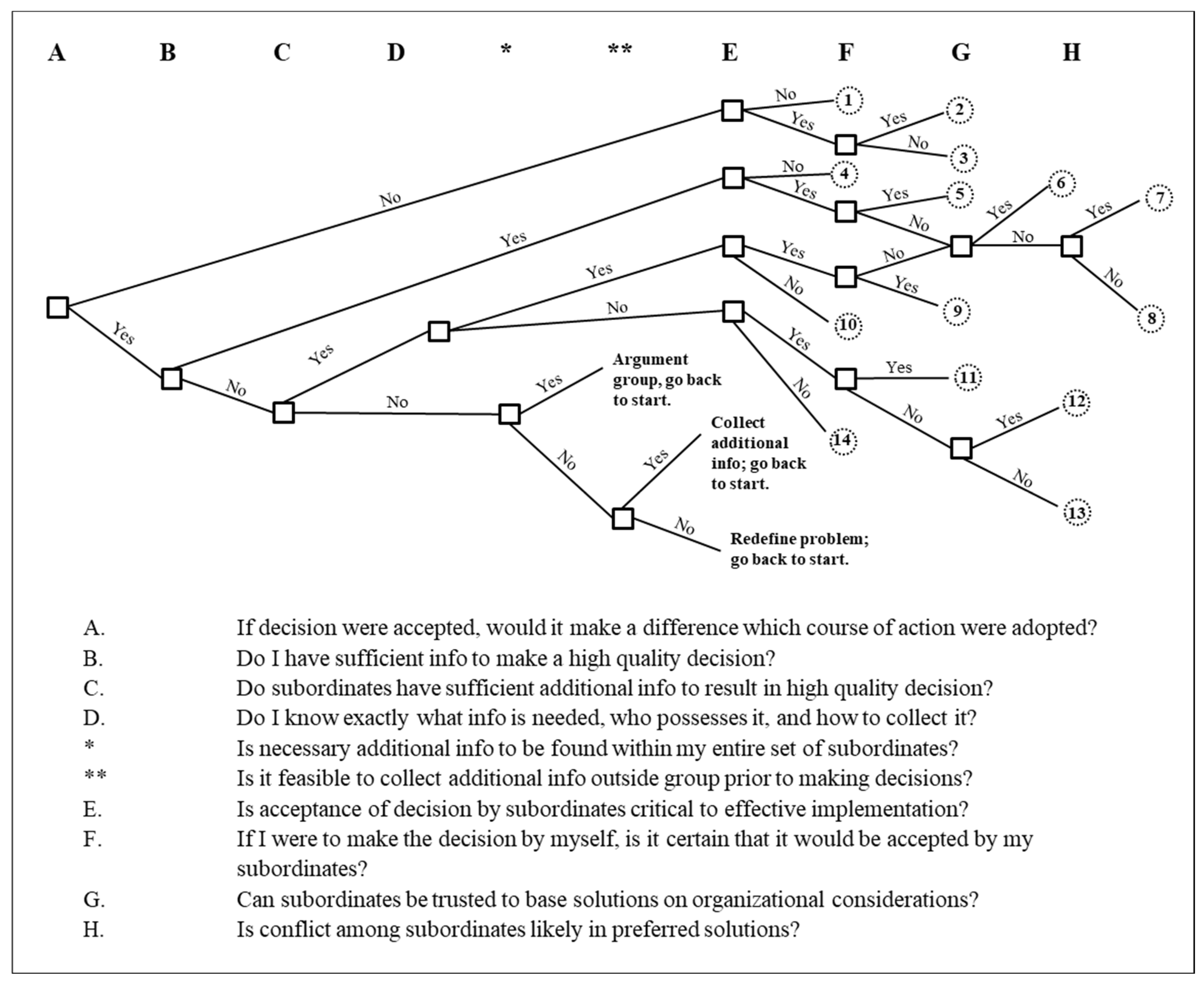
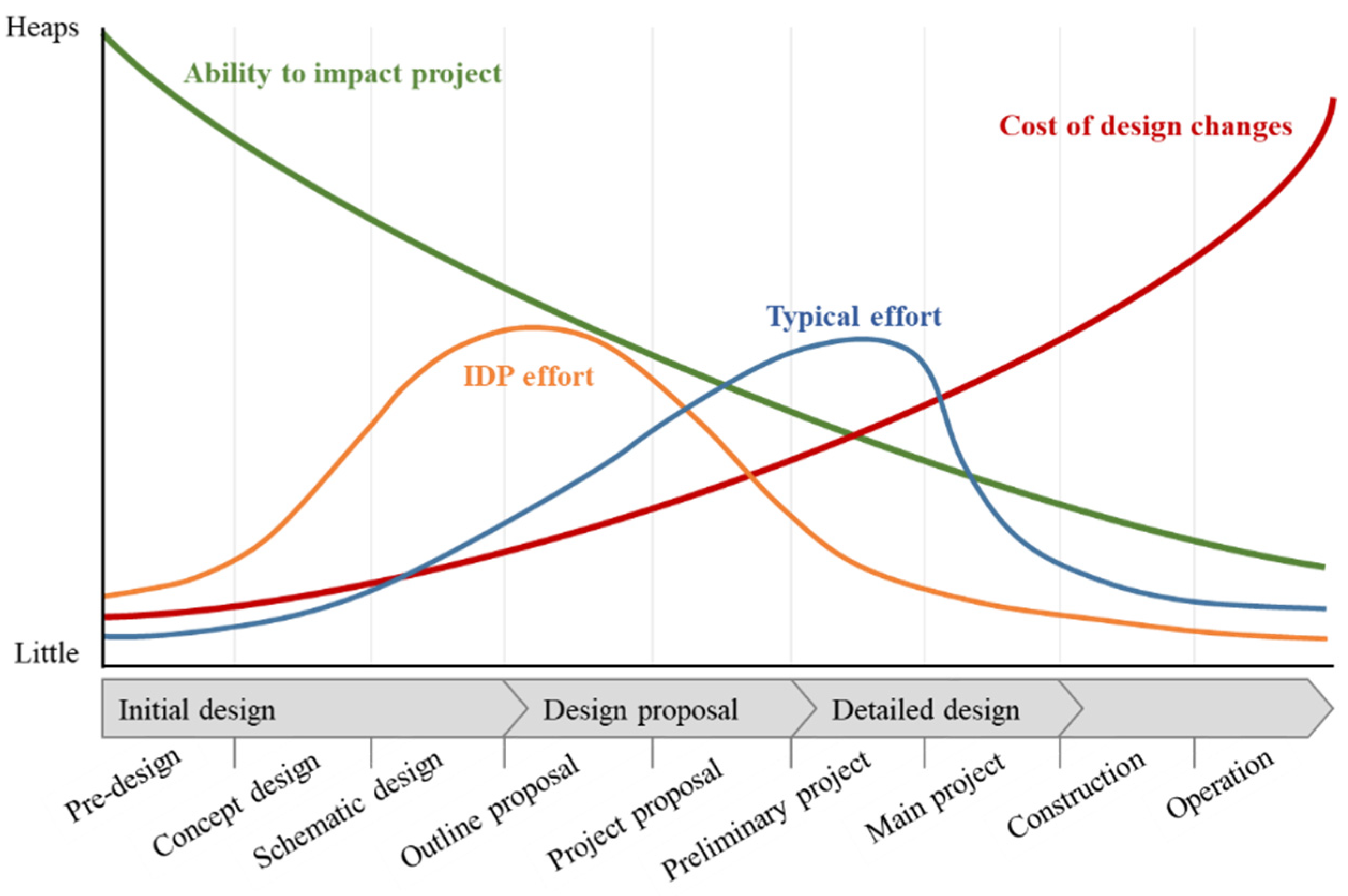
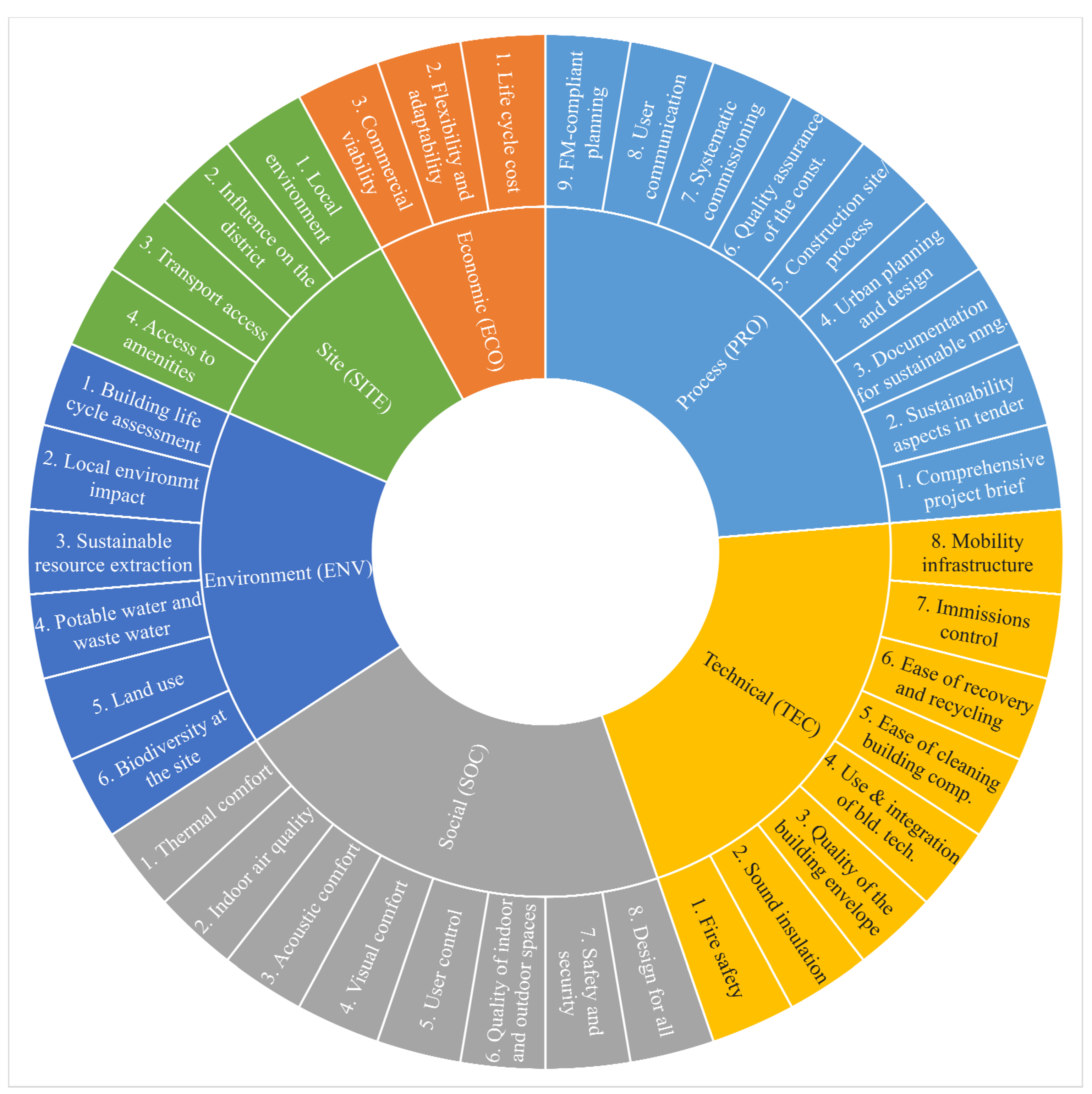
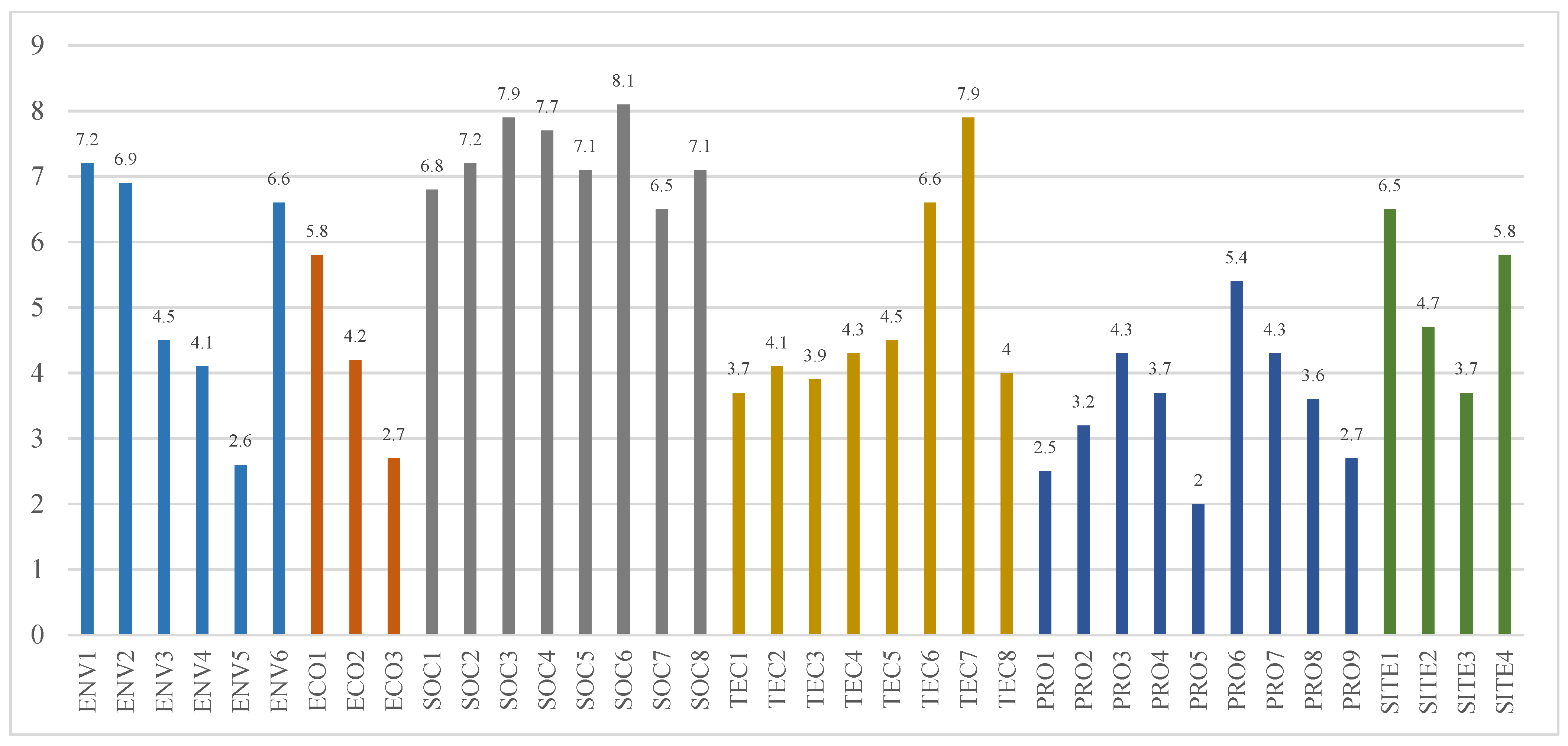

| Rule No. | Rule Description |
|---|---|
| 1. The Leader Information Rule | If the decision quality is important and the leader does not have enough information or expertise to solve the problem alone, then AI is excluded from the feasible set. |
| 2. The Goal Congruence Rule | If the decision quality is important and the subordinates are unlikely to follow the organization’s goals in solving this problem, then GII is eliminated from the feasible set. |
| 3. The Unstructured Problem Rule | In situations where the quality of the decision is important, the leader does not have the necessary information or expertise to solve the problem alone, and the problem is unstructured, the method for solving the problem should involve interaction among subordinates who are likely to have the relevant information. Accordingly, AI, AII, and CI, which give no interaction among subordinates, are excluded from the feasible set. |
| 4. The Acceptance Rule | If acceptance of the decision by subordinates is important for effective implementation and when it is not reasonably certain that an autocratic decision will be accepted. AI and AII are eliminated from the feasible set. |
| 5. The Conflict Rule | When acceptance of the decision is important, acceptance of an autocratic decision is not sufficiently certain, and agreement among subordinates on possible solutions is likely, the methods used to resolve the problem should allow those who disagree to resolve their differences with full knowledge of the problem. Accordingly, under these conditions, AI, AII, and CI, which do not allow interaction among subordinates and therefore do not provide an opportunity for the conflicting parties to resolve their differences, are eliminated from the group of possible solutions. Their use risks that some subordinates will show less than the required commitment to the final decision. |
| 6. The Fairness Rule | When the quality of the decision is unimportant, but the acceptability of the decision is important and not sufficiently certain in the case of an autocratic decision, the decision process must generate the necessary acceptability. The decision process should allow subordinates to interact and negotiate about resolving differences, with full responsibility for deciding what is fair and equitable. Accordingly, AI, AII, CI, and CII are eliminated from the possible set under these circumstances. |
| 7. The Acceptance Priority Rule | When acceptance is important, an autocratic decision cannot be reached with reasonable certainty, and subordinates are motivated to pursue the organizational goals presented in the problem, methods that provide equal partnership in the decision-making process can generate far greater acceptance without compromising the decision quality. Accordingly, AI, AII, CI, and CII are excluded from the set of possible solutions. |
| Problem Type | Acceptable Methods |
|---|---|
| 1 | AI, AII, CI, CII, GI |
| 2 | AI, AII, CI, CII, GI |
| 3 | GI |
| 4 | AI, AII, CI, CII, GI * |
| 5 | AI, AII, CI, CII, GI * |
| 6 | GI |
| 7 | CII |
| 8 | CI, CII |
| 9 | AII, CI, CII, GI * |
| 10 | AII, CI, CII, GI * |
| 11 | CII, GI * |
| 12 | GI |
| 13 | CII |
| 14 | CII, GI * |
| Decision-Stages | Decision-Makers |
|---|---|
|
|
|
|
|
|
|
|
|
|
| |
|
| Design Decision-Stage Relevancy | Design Decision-Maker Relevancy |
|---|---|
| (a) - Cumulative MS for the individual DGNB criteria within each quality - | |
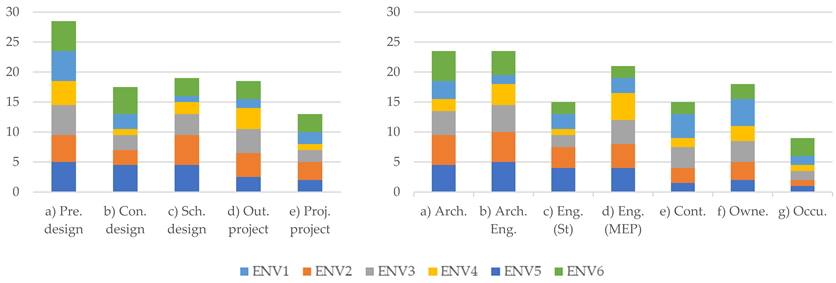 | |
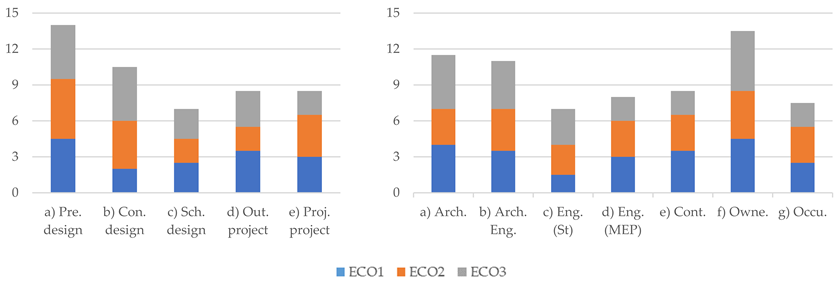 | |
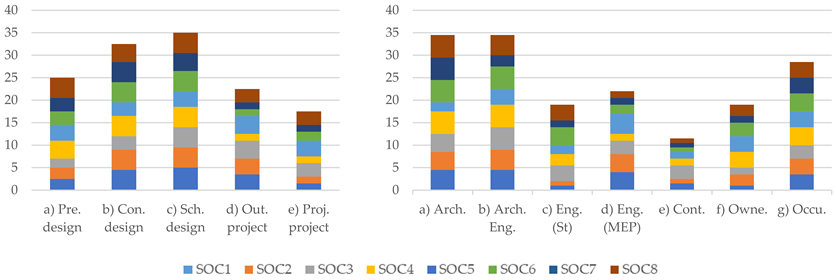 | |
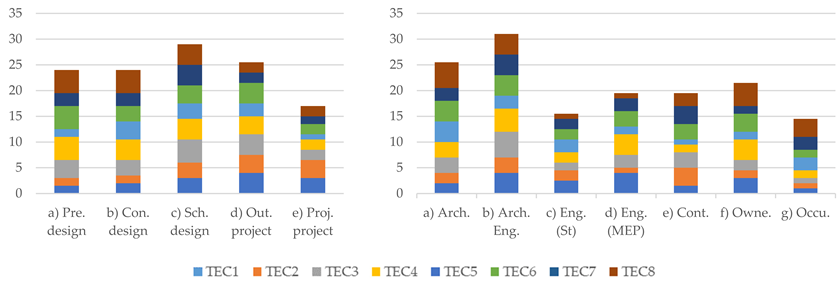 | |
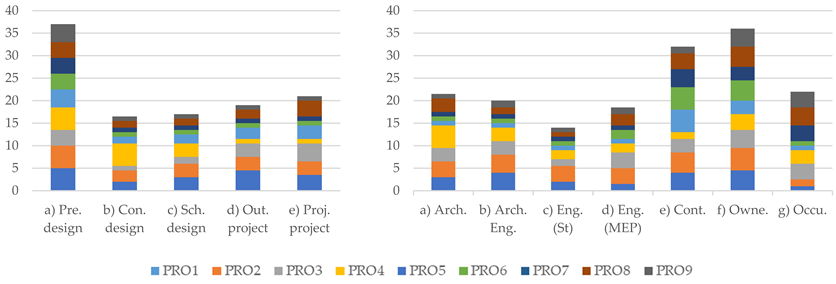 | |
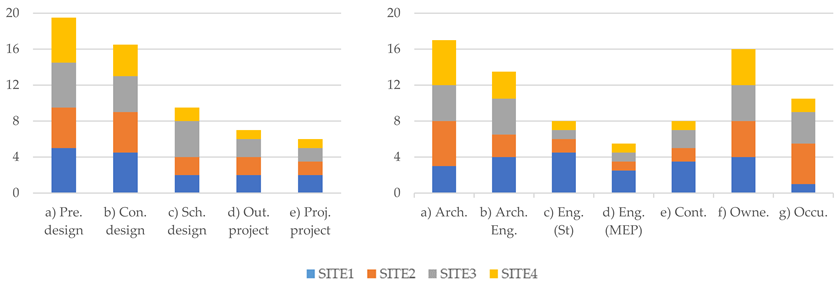 | |
| (b) - Cumulative MS for the individual DGNB qualities - | |
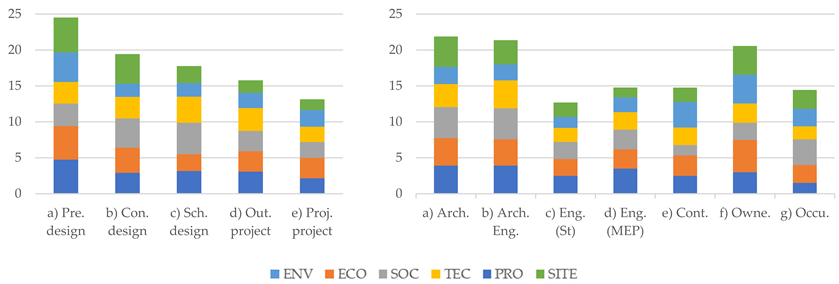 | |
| (c) - Total MS for all DGNB qualities - | |
 | |
Disclaimer/Publisher’s Note: The statements, opinions and data contained in all publications are solely those of the individual author(s) and contributor(s) and not of MDPI and/or the editor(s). MDPI and/or the editor(s) disclaim responsibility for any injury to people or property resulting from any ideas, methods, instructions or products referred to in the content. |
© 2023 by the author. Licensee MDPI, Basel, Switzerland. This article is an open access article distributed under the terms and conditions of the Creative Commons Attribution (CC BY) license (https://creativecommons.org/licenses/by/4.0/).
Share and Cite
Kamari, A. From Decision Theory to Informed Decision-Making in the Design of Sustainable High-Performance Buildings. Sustainability 2023, 15, 15784. https://doi.org/10.3390/su152215784
Kamari A. From Decision Theory to Informed Decision-Making in the Design of Sustainable High-Performance Buildings. Sustainability. 2023; 15(22):15784. https://doi.org/10.3390/su152215784
Chicago/Turabian StyleKamari, Aliakbar. 2023. "From Decision Theory to Informed Decision-Making in the Design of Sustainable High-Performance Buildings" Sustainability 15, no. 22: 15784. https://doi.org/10.3390/su152215784
APA StyleKamari, A. (2023). From Decision Theory to Informed Decision-Making in the Design of Sustainable High-Performance Buildings. Sustainability, 15(22), 15784. https://doi.org/10.3390/su152215784






